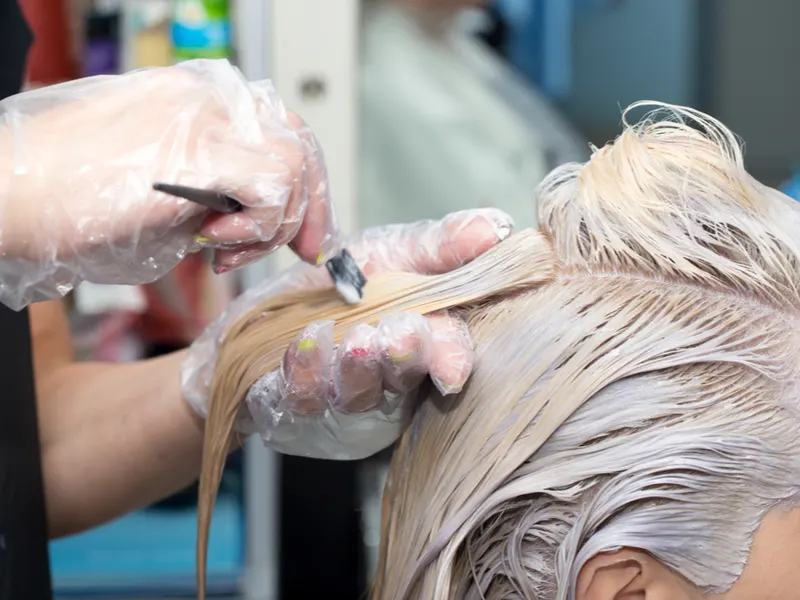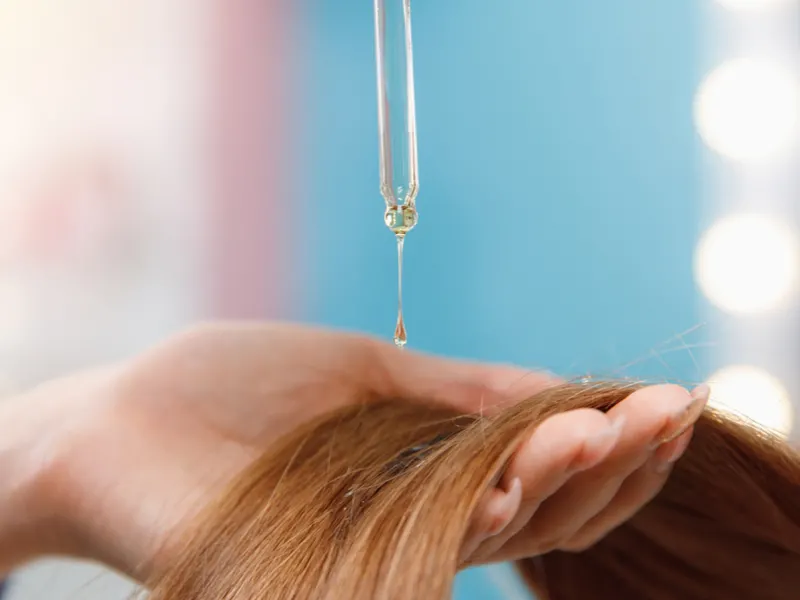Jump to:
What is a chemical cut, and how do you know if you have one? Well, have color treatments damaged your hair? If so, you may be wondering if you can make things better by giving it some TLC or if you’re dealing with the dreaded chemical cut.
We’ll show you what these cuts are, how damaging they can be, how to avoid getting one in the first place, and what to do if you’re unfortunately enough to have one in our complete guide below.
What Is a Chemical Cut?
A chemical haircut is extreme damage caused by things like straightening treatments and coloring. The bonds in the hair become so broken that it essentially breaks off. Signs of a chemical haircut include things like thin, uneven hair, torched ends, and hair breakage.
Even if you didn’t know what to call it until just now, the consequences of a chemical cut are pretty obvious. In most cases, this traumatic event will leave you wondering just what went wrong and how to fix it–or if things are simply beyond repair.
You probably have lots of questions about chemical damage, so today we’re going to cover everything you need to know, including:
- What causes a chemical cut
- How to know if you have one
- What the signs of a chemical cut are
- How to rehab chemically damaged hair
Let’s jump right in and answer your questions.
Read Next: Can You Dye Your Hair After Bleaching?
Why Chemical Cuts Happen

Schamks/Shutterstock
By now, you’ve likely guessed that frequent coloring or straightening treatments have something to do with the damage–and you’d be right. But, more specifically, most cases of chemical damage are caused by something called overlapping.
Overlapping is reprocessing hair that’s already been color-treated, a practice that anyone who’s dyed their hair knows results in weaker locks. Over time, overlapping can lead to breakage, but this usually happens in more extreme cases.
For example, someone going to platinum blonde, then back to their natural color, then back to blonde again is at risk of over-processing.
Another cause could be coloring your hair more frequently than recommended (every six to eight weeks is the sweet spot for most people) or leaving treatments on for extended periods.
Letting hair dye sit on your scalp for too long can cause chemical burns on the scalp, which wouldn’t happen in a salon. However, it’s definitely a horror more than a few at-home colorists have experienced. And it’s a pretty gnarly experience.
What seems like an innocent attempt to get a more vibrant color ends up burning your scalp and your hair. You’re also likely to damage the hair follicle, which, in extreme instances, can cause alopecia.
That’s right–these burns can cause so much damage to the follicle that it permanently stops producing hair.
Read Next: Does Bleaching Your Hair Damage It Forever?
How to Know If You Have a Chemical Cut
If your latest hair treatment has resulted in a chemical cut, the consequences are usually pretty extreme–and obvious. Many people are shocked to see the ends of their hair, which take on a choppy, uneven appearance.
However, some signs are a bit more subtle. If you notice any of the following, it’s time to lay off the treatments and nurse your hair back to health:
- The ends of your hair are breaking apart
- Hair texture is dull, rough, or even rubbery
- You’re losing more hair than normal
- Your hair feels slimy
- Wet hair does not return to its normal shape after pulling
Signs of an Impending Chemical Cut

Marinafrost/Shutterstock
If you regularly color treat your hair (especially at home), you might be wondering what you can do to prevent chemical damage. Are there any signs that let you know your hair is close to its limit?
In most cases, it’s impossible to know that you’re on the road to destruction until it’s too late. You do one treatment too many, and things go very wrong. However, if you regularly monitor your hair, you may be able to head off disaster–specifically by paying close attention to breakage.
A certain amount of breakage is normal, but it’s probably a good idea to ease up on treatments if yours is suddenly getting worse. Another thing to look at is your hair texture. If your texture changes, you may be on the verge of chemical damage.
What should you look for?
Overly dry, brittle hair is a good indicator that something’s up, and so is hair that feels mushy and gummy to the touch. Lastly, if you’re suddenly experiencing excess frizz and cowlicks, your hair is probably trying to tell you something.
Fixing Your Hair After a Chemical Cut
If you’re dealing with a chemical cut, your most pressing question is probably what to do about it. You’ve been left with fragile, butchered hair, and you’re not keen to do more damage.
While not a pleasant experience, think of your chemical cut as an opportunity to start afresh. Plenty of people who’ve had this happen to them decide to do intense rehab, and they end up with hair that’s stronger than it was before.
Stop Everything
First thing’s first: stop all harsh treatments. It may sound obvious, but we have to say it. If you were trying to achieve the platinum-blonde look of your dreams, you’ll have to live with your dark hair for the foreseeable future.
Avoid any treatments that will aggravate your damaged locks further. In other words, no coloring, no curling, and no heat styling.
Cut Your Hair
Yep, you probably figured that this step would be part of the recovery process, and it’s true. First, you have to cut your hair. Visit your stylist and have them remove all the breakage, as the damaged ends no longer serve you.
Know that it’s likely that you’ll have to cut your hair shorter than you’d like to, but this is the best course of action. Otherwise, you’ll be left with a shaggy, uneven do.
Leave It Alone
Once you cut it, the best thing you can do for your hair is to leave it alone (aside from applying nourishing treatments, which we’ll get to in a second). Touch it as little as possible, and try to minimize how much you wash it.
Shampooing minimally allows natural oils to accumulate, protecting and nourishing the scalp. And while it can be challenging, you’ll also want to avoid using harsh alcohol-based products like hairspray.
Shampoo Gently
If you’re like most people, you probably go to town scrubbing your head when it’s time to wash your hair. But being too aggressive is the worst thing you can do, as hair is at its most fragile when wet. Unfortunately, it’s easy to do a lot of damage here inadvertently.
Instead, avoid harsh behaviors. Focus the product on your roots and gently rub it into your scalp. And remember, absolutely no scrubbing or rubbing the ends.
Read Next: What Is a Mild Shampoo?
Get Rid of Excess Water Before Conditioning
This tip will help you get the most out of your conditioner, aka one of the most essential tools in your hair repair arsenal.
Too-wet hair doesn’t absorb conditioner as well as damp hair, so make sure to get rid of excess water before conditioning. Gently squeeze it out, and pin it back with a clip while the product works its magic.
Nourish Your Hair
If you don’t already have them, now’s an ideal time to stock up on all the nourishing products you can get your hands on. Look for strengthening shampoos and conditioners, as well as leave-in conditioners.
Make sure to use these nourishing conditioners regularly.
Hair masks are another yes, and you may want to consider implementing a gentle weekly essential oil massage (peppermint is excellent). Your stylist may also recommend an in-salon protein treatment, excellent for restoring protein and collagen.
Read Next: What Oil Is Best for Hair?
Protect Your Hair From Damage
It’s vital to remember that hair that’s been chemically damaged is very fragile. Aside from being careful in the shower, here are some general hair care best practices to protect your locks.
- Brushing. Use a brush with soft bristles (like a boar bristle brush), and be very mindful when brushing. Avoid brushing wet hair, which can cause more damage. Always start at the ends and slowly work your way up.
- Invest in a microfiber towel. You may be surprised to learn that regular towels are terrible for drying hair, as they can cause frizzing and splitting. A microfiber towel that gently absorbs moisture is a better option.
- Swap your pillowcase. If you don’t already have a silk pillowcase, now’s a great time to get one. Unlike cotton, a silk pillowcase reduces friction and helps your hair stay hydrated.
- Avoid certain hairstyles. Tight updos or exceptionally high or sleek ponytails are a no-no on your hair healing journey.
Prevent Future Damage
Most people who’ve experienced traumatic hair damage learn their lesson. As a result, they usually rethink their hair care routine and proceed with caution to prevent future damage.
Yet learning your lesson doesn’t mean you can never color or heat style your hair again. Instead, it means that you should consider the frequency of these treatments when the time comes.
As you ease back into coloring your idea, it’s an excellent idea to start at a reputable salon (especially if you were using at-home dyes). An experienced professional can help determine what a healthy coloring routine frequency should look like for you.
They can also assess the state of your hair each time you go in. Finally, another way to head off a future chemical cut is to bolster your hair care routine with the aforementioned nourishing products.
Frequently Asked Questions

Parilov/Shutterstock
Here is a list of the most commonly asked questions regarding chemical cuts.
How can I prevent chemical cuts if I color my hair at home?
The best way to avoid this problem is to perform a wickness test before coloring your hair. Apply your treatment to a strand on the back of your neck, and wait to see how it reacts before dyeing the rest of your hair.
Can I reverse the damage of a chemical cut?
Unfortunately, once the damage is done, there’s no easy fix. You’ll need to take some drastic measures, which include cutting off all the damaged hair and avoiding the treatments that caused the problems in the first place.
How long does it take to recover from a chemical cut?
It's impossible to give a one-size-fits-all timeline. Depending on the damage, rehabbing your hair could take several weeks to several months, sometimes a year or two. Remember that the damage didn’t happen overnight, nor will the repair.
Will hair grow back after chemical damage?
Most people successfully grow their hair back after a chemical cut. However, in extreme cases of hair follicle damage, you may end up with permanent hair loss that requires surgical treatments to fix.
So, What Is a Chemical Cut?
So-called “chemical cuts” result from overusing dyes, bleaches, and hair relaxants. The hair becomes so damaged that it’s best to cut your losses (literally) and start again.
While it will take a great deal of time and care to get your locks in tip-top shape, consider it an investment in long-term hair health.
